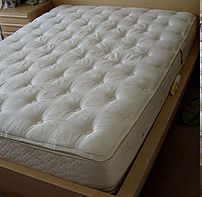Is There a Relationship Between Housework and Sex?
Francis Githinji
Nowadays, men are more free with carrying out household chores than in the yesteryears. According to a study in the university of Michigan's Institute for social research, a third percentage of men are doing house work. In 1976, men used approximately six hours every week in house work but since the year 2005 the hours have increased to thirteen. The interesting thing is that, women housework weekly hours were cut from 26 to 17. The source was reliable since it was based on health, economics, and social data obtained from thousands of families. In a woman's point of view, when a husband helps with the housework it is the ultimate expression of care and concern. This translates into reduced stress and more relaxation. This explains the real connection between housework and sex. When a guy is stressed, he might want to burn it out by making love. Women are different since they need to relax in order to feel romantic and want sex.
Women are more likely to find these kind of men to be more romantic. A relationship between housework and sex can be explained in that when two partners engage in house chores extra time is created allowing time for foreplay and sleep. Women confessed of being overly turned on by husbands who help them do the house work. For instance if the dishes are full in the sink and the food is yet to be cooked the husband knows that the woman will be reluctant to get intimate before the chores are all done. If the wife has so much to do and the husband is oblivious, the wife might result to being resentful. Wives like it when the household chores are shared but they also think that husbands intentionally create more work for them. This proves that it is not an easy task to make a relationship work. A lot of work is done to maintain a relationship.
Both the wife and the husband dream of a happy and clean home but a wife contributes more to the tidiness. Research has shown that men create more house work. It might not be doing the dishes or mowing the lawn but emotional labor. The wives are left with chores like organizing family gatherings, planning family medical opportunities or buying and organizing Christmas gifts. No matter the findings the research says that the equality in labor can never be achieved as long the invisible labor is a responsibility of the woman. Much accumulated house work can result into mental stress if it is mismanaged. There are gender dynamics which are wide sweeping all the family people in America and especially in the housework field. Women and especially house wives are most of the time moody by the time the partner gets home in the evening. There must be a connection between housework and sex because carrier women have been reported to be more sexy.
An information architect and also a father of two twins who was interviewed said that he can never regret the time he spends parenting or house keeping as it has proved to be very fruitful. He said it creates a very healthy romantic relationship with his wife. Such men might be few but they are the most sought after. Interestingly, the more the husbands help, the more the wives are happy in marriage but the husbands are less happy in the marital status. I do not love house work and i doubt if anybody does but it has to be done as an expression of shared couple hood. If it is shared off course sex is shared and so the spirit of sharing will be evident in the couple. The relationship between housework and sex is just that strong.
Nowadays, men are more free with carrying out household chores than in the yesteryears. According to a study in the university of Michigan's Institute for social research, a third percentage of men are doing house work. In 1976, men used approximately six hours every week in house work but since the year 2005 the hours have increased to thirteen. The interesting thing is that, women housework weekly hours were cut from 26 to 17. The source was reliable since it was based on health, economics, and social data obtained from thousands of families. In a woman's point of view, when a husband helps with the housework it is the ultimate expression of care and concern. This translates into reduced stress and more relaxation. This explains the real connection between housework and sex. When a guy is stressed, he might want to burn it out by making love. Women are different since they need to relax in order to feel romantic and want sex.
Women are more likely to find these kind of men to be more romantic. A relationship between housework and sex can be explained in that when two partners engage in house chores extra time is created allowing time for foreplay and sleep. Women confessed of being overly turned on by husbands who help them do the house work. For instance if the dishes are full in the sink and the food is yet to be cooked the husband knows that the woman will be reluctant to get intimate before the chores are all done. If the wife has so much to do and the husband is oblivious, the wife might result to being resentful. Wives like it when the household chores are shared but they also think that husbands intentionally create more work for them. This proves that it is not an easy task to make a relationship work. A lot of work is done to maintain a relationship.
Both the wife and the husband dream of a happy and clean home but a wife contributes more to the tidiness. Research has shown that men create more house work. It might not be doing the dishes or mowing the lawn but emotional labor. The wives are left with chores like organizing family gatherings, planning family medical opportunities or buying and organizing Christmas gifts. No matter the findings the research says that the equality in labor can never be achieved as long the invisible labor is a responsibility of the woman. Much accumulated house work can result into mental stress if it is mismanaged. There are gender dynamics which are wide sweeping all the family people in America and especially in the housework field. Women and especially house wives are most of the time moody by the time the partner gets home in the evening. There must be a connection between housework and sex because carrier women have been reported to be more sexy.
An information architect and also a father of two twins who was interviewed said that he can never regret the time he spends parenting or house keeping as it has proved to be very fruitful. He said it creates a very healthy romantic relationship with his wife. Such men might be few but they are the most sought after. Interestingly, the more the husbands help, the more the wives are happy in marriage but the husbands are less happy in the marital status. I do not love house work and i doubt if anybody does but it has to be done as an expression of shared couple hood. If it is shared off course sex is shared and so the spirit of sharing will be evident in the couple. The relationship between housework and sex is just that strong.
![Reblog this post [with Zemanta]](http://img.zemanta.com/reblog_e.png?x-id=a9a44259-9566-450c-a02e-15dd4a595e39)

![Reblog this post [with Zemanta]](http://img.zemanta.com/reblog_e.png?x-id=0d453d1c-2fc0-4cef-95a0-5f31733bcb26)

![Reblog this post [with Zemanta]](http://img.zemanta.com/reblog_e.png?x-id=55b8b60d-afcd-44e7-9979-2650558282fa)

![Reblog this post [with Zemanta]](http://img.zemanta.com/reblog_e.png?x-id=97c85399-e9a6-49fd-bd6a-bfda999e2cf2)

![Reblog this post [with Zemanta]](http://img.zemanta.com/reblog_e.png?x-id=88d7c0da-5141-4607-a471-a3734ebdf3a9)

![Reblog this post [with Zemanta]](http://img.zemanta.com/reblog_e.png?x-id=56c7ccac-5acb-4204-aee7-3e290cd36205)

![Reblog this post [with Zemanta]](http://img.zemanta.com/reblog_e.png?x-id=8d25a04b-1303-4766-bb3d-ebeb38b658d4)

![Reblog this post [with Zemanta]](http://img.zemanta.com/reblog_e.png?x-id=9fb3a866-1520-44a5-ba7f-ef7a604bc466)

